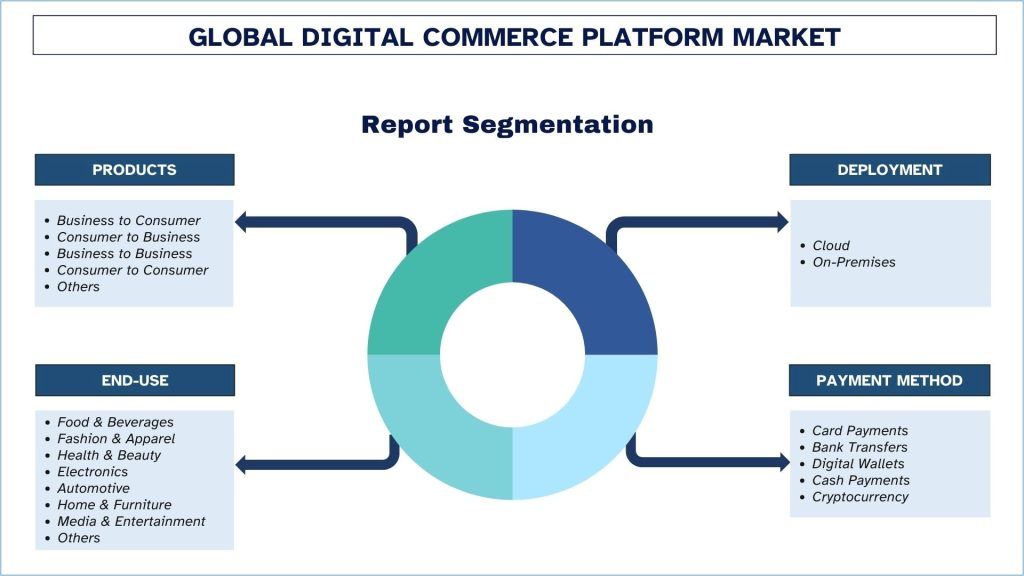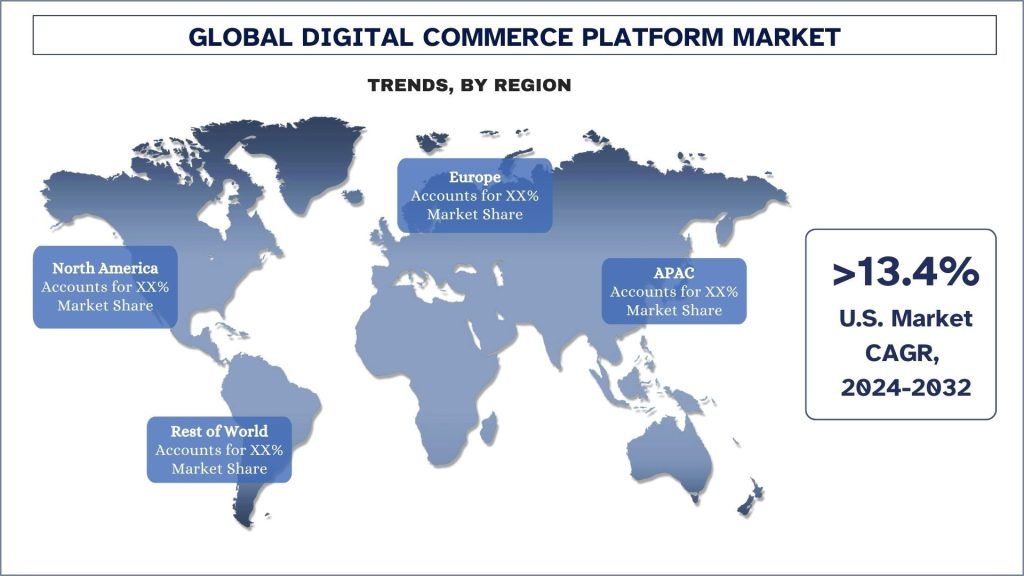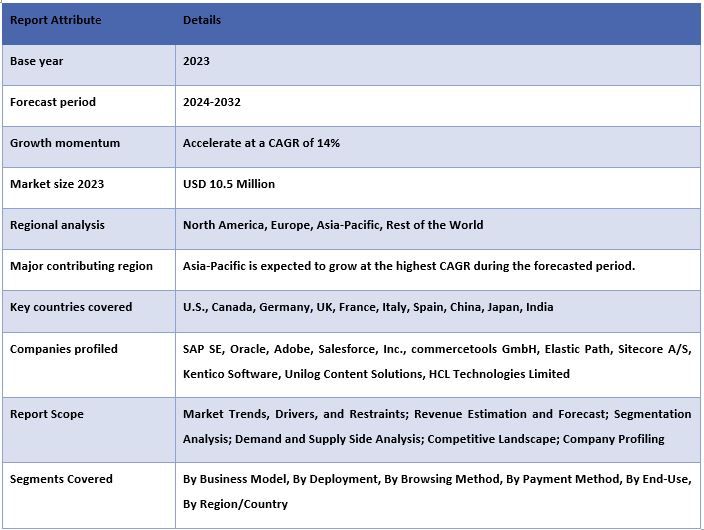- Home
- About Us
- Industry
- Services
- Reading
- Contact Us
Digital Commerce Platform Market : Current Analysis and Forecast (2024-2032)
Emphasis on, Business model (Business to Consumer, Consumer to business, business to business, Consumer to consumer, and Others) Deployment (On-Premises and Cloud); Browsing method, (desktop/laptop and mobile/tablet); Payment model(card payments, bank transfers, digital wallets, cash payments, and cryptocurrencies) End-user (Food & Beverages, Fashion & Apparels, Health & Beauty, Electronics, Automotive, Home & Furniture, Media & Entertainment, Others) and Region/Country.
Digital Commerce Platform Market Size & Forecast
The Digital Commerce Platform Market was valued at approximately USD 10.5 Million in 2023 and is expected to grow at a substantial CAGR of around 14% during the forecast period (2024-2032) owing to the increased internet penetration and widespread adoption of smartphones.
Digital Commerce Platform Market Analysis
Digital Commerce Platform is an overarching term that refers to a solution collection that helps a business manage sales across digital touchpoints. It consolidates essential processes such as managing a product catalog, processing payments, managing customer interactions, and handling orders. It helps make omnichannel experiences, in websites, mobile applications, and social media, possible. These are solutions aimed at helping businesses manage their e-commerce websites and portals and address the tasks that may be difficult to solve when using standard shopping carts.
The rising adoption of internet penetration. As per the Our World in Data.org, only 63% of the world’s population was online in 2023. For better growth in the realm of digital commerce, many companies are incorporating headless commerce architectures which help in front-end flexibility while also enabling a quick shift according to consumer behavior. These are also utilizing AI-driven product recommendations to improve customers’ interactions and purchases, besides adopting omnichannel techniques for smooth client experiences online and offline. Furthermore, by adopting cloud applications organizations are observing adaptability, cost-cutting, and effectiveness in their operations. For instance, in March 2024, SAP SE announced a new composable payment solution to help retailers stay ahead of changing customer expectations. The new solution, SAP Commerce Cloud, an open payment framework, helps retailers become more agile as new payment options – such as buy now, pay later – gain popularity.
Digital Commerce Platform Market Trends
This section discusses the key market trends influencing the various segments of the Digital Commerce Platform market as identified by our research experts.
Business-to-Consumer (B2C) Transforms Digital Commerce Platform Industry
The use of the Business-to-Consumer (B2C) segment has led to the growth of the digital commerce market through embracing the use of internet and Mobile commerce coupled with the changing consumer trends that extend their shopping preferences online. The B2C organizations are increasingly incorporating digital commerce solutions to enable perfect and unified shopping experiences with relevant recommendations and smooth payment options. To drive growth, added AI-driven analytics for improving customers’ understanding, mobile-first approach to enable consumption of digital services by those with smartphones, and social commerce enablers to engage customers using new channels like Instagram and TikTok. This orientation towards production gives customer-centric innovations a better lift in conversion rates and brand identification.

North America leads the market.
North America holds the largest share in the market of Digital Commerce Platform. The growth of the digital commerce platform market in North America is attributed to high internet connectivity, advanced mobility, and the adoption by consumers of online shopping. As of 2024, 94.6% of Americans have access to the internet. As of 2024, the Internet is accessible to nearly 95% of the United States population, or about 322,563,519 individuals, according to a U.S. Census. The e-commerce infrastructure is relatively more developed than the other regions of the world, along the ever-growing demand for omnichannel solutions, compels businesses to embrace advanced digital commerce tools.
Digital Commerce Platform Industry Overview
The Digital Commerce Platform market is competitive, with several global and international players. The key players are adopting different growth strategies to enhance their market presence, such as partnerships, agreements, collaborations, new product launches, geographical expansions, and mergers and acquisitions. Some of the major players operating in the market are SAP SE, Oracle, Adobe, Salesforce, Inc., commercetools GmbH, Elastic Path, Sitecore A/S, Kentico Software, Unilog Content Solutions, HCL Technologies Limited.

Digital Commerce Platform Market News
On September 11, 2024: The Open Network for Digital Commerce (ONDC) launched Saarthi, a reference application designed to assist businesses in creating their own customized buyer-side apps. Developed together with Bhashini — an AI-driven language translation tool, Saarthi provides a comprehensive framework to Network Participants that enables seamless integration with ONDC, offering advanced multilingual capabilities for a more inclusive digital commerce experience.
In March 2023, SAP SE announced that Swarovski, the world’s premier jewelry and accessories brand, has chosen the RISE with SAP solution and the SAP Commerce Cloud solution to move its complete SAP software-based digital backbone and e-commerce landscape to the cloud to help save costs and improve efficiency.
Digital Commerce Platform Market Report Coverage

Reasons to buy this report:
- The study includes market sizing and forecasting analysis validated by authenticated key industry experts.
- The report presents a quick review of overall industry performance at one glance.
- The report covers an in-depth analysis of prominent industry peers with a primary focus on key business financials, product portfolios, expansion strategies, and recent developments.
- Detailed examination of drivers, restraints, key trends, and opportunities prevailing in the industry.
- The study comprehensively covers the market across different segments.
- Deep dive regional level analysis of the industry.
Customization Options:
The global Digital Commerce Platform market can be customized further as per the requirement or any other market segment. Besides this, UMI understands that you may have your own business needs, hence feel free to connect with us to get a report that completely suits your requirements.
Table of Content
Research Methodology for the Digital Commerce Platform Market Analysis (2022-2032)
Analyzing the historical market, estimating the current market, and forecasting the future market of the global Digital Commerce Platform market were the three major steps undertaken to create and analyze the adoption of Digital Commerce Platform in major regions globally. Exhaustive secondary research was conducted to collect the historical market numbers and estimate the current market size. Secondly, to validate these insights, numerous findings and assumptions were taken into consideration. Moreover, exhaustive primary interviews were also conducted, with industry experts across the value chain of the global Digital Commerce Platform market. Post assumption and validation of market numbers through primary interviews, we employed a top-down/bottom-up approach to forecasting the complete market size. Thereafter, market breakdown and data triangulation methods were adopted to estimate and analyze the market size of segments and sub-segments of the industry. Detailed methodology is explained below:
Analysis of Historical Market Size
Step 1: In-Depth Study of Secondary Sources:
A detailed secondary study was conducted to obtain the historical market size of the Digital Commerce Platform market through company internal sources such as annual reports & financial statements, performance presentations, press releases, etc., and external sources including journals, news & articles, government publications, competitor publications, sector reports, third-party database, and other credible publications.
Step 2: Market Segmentation:
After obtaining the historical market size of the Digital Commerce Platform market, we conducted a detailed secondary analysis to gather historical market insights and share for different segments & sub-segments for major regions. Major segments are included in the report as business model, deployment, browsing method, payment method, end-use, and regions. Further country-level analyses were conducted to evaluate the overall adoption of testing models in that region.
Step 3: Factor Analysis:
After acquiring the historical market size of different segments and sub-segments, we conducted a detailed factor analysis to estimate the current market size of the Digital Commerce Platform market. Further, we conducted factor analysis using dependent and independent variables such as business model, deployment, browsing method, payment method, end-use, and regions of the Digital Commerce Platform market. A thorough analysis was conducted for demand and supply-side scenarios considering top partnerships, mergers and acquisitions, business expansion, and product launches in the Digital Commerce Platform market sector across the globe.
Current Market Size Estimate & Forecast
Current Market Sizing: Based on actionable insights from the above 3 steps, we arrived at the current market size, key players in the global Digital Commerce Platform market, and market shares of the segments. All the required percentage shares split and market breakdowns were determined using the above-mentioned secondary approach and were verified through primary interviews.
Estimation & Forecasting: For market estimation and forecast, weights were assigned to different factors including drivers & trends, restraints, and opportunities available for the stakeholders. After analyzing these factors, relevant forecasting techniques i.e., the top-down/bottom-up approach were applied to arrive at the market forecast for 2032 for different segments and sub-segments across the major markets globally. The research methodology adopted to estimate the market size encompasses:
- The industry’s market size, in terms of revenue (USD) and the adoption rate of the Digital Commerce Platform market across the major markets domestically
- All percentage shares, splits, and breakdowns of market segments and sub-segments
- Key players in the global Digital Commerce Platform market in terms of products offered. Also, the growth strategies adopted by these players to compete in the fast-growing market
Market Size and Share Validation
Primary Research: In-depth interviews were conducted with the Key Opinion Leaders (KOLs) including Top Level Executives (CXO/VPs, Sales Head, Marketing Head, Operational Head, Regional Head, Country Head, etc.) across major regions. Primary research findings were then summarized, and statistical analysis was performed to prove the stated hypothesis. Inputs from primary research were consolidated with secondary findings, hence turning information into actionable insights.
Split of Primary Participants in Different Regions

Market Engineering
The data triangulation technique was employed to complete the overall market estimation and to arrive at precise statistical numbers for each segment and sub-segment of the global Digital Commerce Platform market. Data was split into several segments and sub-segments after studying various parameters and trends in the business model, deployment, browsing method, payment method, end-use, and regions of the global Digital Commerce Platform market.
The main objective of the Global Digital Commerce Platform Market Study
The current & future market trends of the global Digital Commerce Platform market were pinpointed in the study. Investors can gain strategic insights to base their discretion for investments on the qualitative and quantitative analysis performed in the study. Current and future market trends determined the overall attractiveness of the market at a regional level, providing a platform for the industrial participant to exploit the untapped market to benefit from a first-mover advantage. Other quantitative goals of the studies include:
- Analyze the current and forecast market size of the Digital Commerce Platform market in terms of value (USD). Also, analyze the current and forecast market size of different segments and sub-segments.
- Segments in the study include areas of the business model, deployment, browsing method, payment method, end-use, and regions.
- Define and analyze the regulatory framework for the Digital Commerce Platform
- Analyze the value chain involved with the presence of various intermediaries, along with analyzing customer and competitor behaviors of the industry.
- Analyze the current and forecast market size of the Digital Commerce Platform market for the major region.
- Major countries of regions studied in the report include Asia Pacific, Europe, North America, and the Rest of the World
- Company profiles of the Digital Commerce Platform market and the growth strategies adopted by the market players to sustain the fast-growing market.
- Deep dive regional level analysis of the industry
Frequently Asked Questions FAQs
Q1: What is the Digital Commerce Platform market's current size and growth potential?
Q2: What are the driving factors for the growth of the Digital Commerce Platform market?
Q3: Which segment has the largest share of the Digital Commerce Platform market by business model?
Q4: What are the major trends in the Digital Commerce Platform market?
Q5: Which region will dominate the Digital Commerce Platform market?
Related Reports
Customers who bought this item also bought











